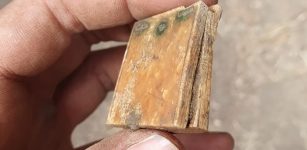Riddle Of Two Undeciphered Elamite Scripts
A. Sutherland - AncientPages.com - The Proto-Elamite script is the world's oldest system of writing that has yet to be deciphered. This Early Bronze Age writing was briefly in use before the introduction of Elamite cuneiform.
Susa III/ Proto-Elamite cylinder seal with bulls and lion, 3100-2900 BC, Louvre Museum, reference Sb 6166. Source
Later, Elamite cuneiform was adapted from Akkadian Cuneiform and used from c. 2500 to 331 BC. It consisted of roughly 130 glyphs and only a few logograms from Akkadian. Over time, the number of logograms increased, and the writing consists of about 20,000 tablets and fragments. Most of them belong to the Achaemenid Era (730 – 330 BC) and contain mainly financial records.
The Proto-Elamite script consists of about 1,000 signs and is therefore thought to be partly logographic (with written characters representing a word or a small meaning).
The name "Proto-Elamite" refers to a writing system in use in the Susa plain and the Iranian highlands located east of Mesopotamia (ca. 3100 (3050) and 2900 (2700) B.C., a period generally believed to correspond to the Uruk III /Jamdat Nasr through Early Dynastic I periods in Mesopotamia.
Economic tablet in Proto-Elamite, Suse III, Louvre Museum, reference Sb 15200, circa 3100-2850 BC. Image source - Mbzt - CC BY 3.0
Proto-Elamite tablets represent the earliest complex written documents from the region. The script consists of numerical and ideographic signs, and the latter sometimes assumed to represent a genetically related forerunner of the Old Elamite language. However, this supposed forerunner language is unknown, and the script itself has been only partially deciphered.
The Proto-Elamite script is thought to have been developed from early Sumerian writing. It was used over a vast geographical area, stretching from the ancient city of Susa in the west, to Tepe Yahya in the east, and perhaps even beyond. The knowledge about this language comes from approximately 1600 existing tablets, and most of them were unearthed at Susa.
The very old are also early cuneiform writing and hieroglyphics; however, if we think of mental work needed to read the Elamite scripts, generally, it is more challenging than reading the hieroglyphics.
Francois Desset And Linear Elamite Script
The linear Elamite script was used in the kingdom of Elam for several centuries, between the end of the third and the beginning of the second millennium B.C.
Not long ago, more precisely in 2020, Francois Desset of the Laboratoire Archeorient in Lyon, France, announced a decipherment and translation of a Linear Elamite script - phonetic writing of cuneiform type used 4,400 years ago in what is now Iran.
Multiple clay tablets covered with this handwriting were first unearthed in the ancient ruins of Susa in 1901. For the last 120 years, linguists could not decipher and eventually fully understand what was written more than four millennia ago.
Until today, the proto-cuneiform script from Mesopotamia dated to around 3300 BC.was considered the oldest example of writing.
However, reading the Linear Elamite script makes us change our view on this subject. Now, it is known that in parallel, around 2300 BC, according to Desset, another system of writing was emerging, and its oldest version (proto-Elamite script), maybe as ancient as the oldest Mesopotamian proto-cuneiform tablets.
In short, the first does not constitute a "mother writing" of which the proto-Elamite would be the daughter. In reality, they are like "two sisters."
 Economic tablet with numeric signs and Proto-Elamite script. Clay accounting tokens, Uruk period. From the Tell of the Acropolis in Susa. Image source - Marie-Lan Nguyen - CC BY 2.5
Economic tablet with numeric signs and Proto-Elamite script. Clay accounting tokens, Uruk period. From the Tell of the Acropolis in Susa. Image source - Marie-Lan Nguyen - CC BY 2.5
Desset concludes that the script did not first appear in Mesopotamia and later in the region of present-day Iran. Instead, these two writing systems (Mesopotamian Proto – Cuneiform and Iran's Proto-Elamite) existed in parallel. It was the same writing system that evolved and was recorded differently in different historical periods.
It is an important discovery (Desset's work still awaits a scientific review) that significantly changes our view of the development of the script. We even have to reconsider all the consequences associated with it.
The Linear Elamite script is different from the cuneiform script, a combination of phonograms, which are signs for identifying sounds, with logograms (signs for identifying things, words, or ideas). Linear Elamite writing, on the other hand, is phonetic writing. Individual characters mean syllables, consonants, and vowels. It was, along with proto-Elamite writing, used from about 3300 to about 1900 B.C. At this time, there was a significant evolution of this writing.
For now, it is uncertain whether the Proto-Elamite script was the direct forerunner of Linear Elamite.
Both scripts remain undeciphered. A clear relationship between these two old languages is not proved but can only be speculated.
Written by – A. Sutherland - AncientPages.com Senior Staff Writer
Copyright © AncientPages.com All rights reserved. This material may not be published, broadcast, rewritten or redistributed in whole or part without the express written permission of AncientPages.com
Expand for referencesMore From Ancient Pages
-
 Face Of Very Old “Vampire” Buried In Connecticut Reconstructed
Archaeology | Nov 9, 2022
Face Of Very Old “Vampire” Buried In Connecticut Reconstructed
Archaeology | Nov 9, 2022 -
 New Clues About The Kensington Runestone Rewrite Ancient History But One Mystery Remains
Featured Stories | May 20, 2025
New Clues About The Kensington Runestone Rewrite Ancient History But One Mystery Remains
Featured Stories | May 20, 2025 -
 Yokai Amabie – Protective Ancient Spirit That Can Ward Off Epidemics
Featured Stories | Mar 30, 2020
Yokai Amabie – Protective Ancient Spirit That Can Ward Off Epidemics
Featured Stories | Mar 30, 2020 -
 Extremely Rare And Tiny Medieval Sundial Discovered In Germany
Archaeology | Jul 31, 2023
Extremely Rare And Tiny Medieval Sundial Discovered In Germany
Archaeology | Jul 31, 2023 -
 Venus Cloacina: Roman Goddess Of Sewers And Drains
Featured Stories | Dec 19, 2019
Venus Cloacina: Roman Goddess Of Sewers And Drains
Featured Stories | Dec 19, 2019 -
 Face Of Queen Lady Cao Reconstructed – Unique Look At The First Known Female Ruler In Peru
Archaeology | Jul 10, 2017
Face Of Queen Lady Cao Reconstructed – Unique Look At The First Known Female Ruler In Peru
Archaeology | Jul 10, 2017 -
 Monte d’Accoddi – Mesopotamian Ziggurat In Europe Built By King Of Uruk?
Featured Stories | Feb 5, 2018
Monte d’Accoddi – Mesopotamian Ziggurat In Europe Built By King Of Uruk?
Featured Stories | Feb 5, 2018 -
 Defixiones: Ancient Roman Curse Tablets Became Big Business
Ancient History Facts | Apr 10, 2016
Defixiones: Ancient Roman Curse Tablets Became Big Business
Ancient History Facts | Apr 10, 2016 -
 Athena – Goddess Of Wisdom Delivered Punishments And Gifts
Featured Stories | Dec 31, 2018
Athena – Goddess Of Wisdom Delivered Punishments And Gifts
Featured Stories | Dec 31, 2018 -
 Enigmatic Denisovans Interbred With Modern Humans More Than Once
Archaeology | Mar 22, 2018
Enigmatic Denisovans Interbred With Modern Humans More Than Once
Archaeology | Mar 22, 2018 -
 Around 1400 Something Dramatic Happened On Gotska Sandön In The Baltic Sea
Archaeology | Aug 15, 2025
Around 1400 Something Dramatic Happened On Gotska Sandön In The Baltic Sea
Archaeology | Aug 15, 2025 -
 Sailor’s Strange Discovery Of An Unknown Ancient Underground World At The North Pole
Featured Stories | Feb 10, 2024
Sailor’s Strange Discovery Of An Unknown Ancient Underground World At The North Pole
Featured Stories | Feb 10, 2024 -
 Mystery Of Gribshunden – Danish Royal Sunken Ship Sheds New Light On Psychological Warfare In The Middle Ages
Archaeology | Apr 14, 2017
Mystery Of Gribshunden – Danish Royal Sunken Ship Sheds New Light On Psychological Warfare In The Middle Ages
Archaeology | Apr 14, 2017 -
 Pomerania’s Remarkable Find: 6,000-Year-Old Limestone Venus Figurine Represents Fertility Symbol Of Central And Eastern Europe
Artifacts | Jun 23, 2025
Pomerania’s Remarkable Find: 6,000-Year-Old Limestone Venus Figurine Represents Fertility Symbol Of Central And Eastern Europe
Artifacts | Jun 23, 2025 -
 House Of Dragons – Stories And British History That Inspired The Beasts Of Westeros
Featured Stories | Sep 18, 2022
House Of Dragons – Stories And British History That Inspired The Beasts Of Westeros
Featured Stories | Sep 18, 2022 -
 Sami God Horagalles Who Ruled Over Rain, Fire And Thunder Hated Evil Spirits
Featured Stories | Feb 11, 2024
Sami God Horagalles Who Ruled Over Rain, Fire And Thunder Hated Evil Spirits
Featured Stories | Feb 11, 2024 -
 Ethical Ancient DNA Research Must Involve Descendant Communities – Researchers Say
Archaeology | Jan 13, 2023
Ethical Ancient DNA Research Must Involve Descendant Communities – Researchers Say
Archaeology | Jan 13, 2023 -
 Beer Was Used As Medicine And Payment In Ancient Egypt
Ancient History Facts | Feb 11, 2018
Beer Was Used As Medicine And Payment In Ancient Egypt
Ancient History Facts | Feb 11, 2018 -
 Neanderthals In Swabian Jura Used Complex Tool-Making Techniques 45,000 Years Ago
Archaeology | Sep 8, 2021
Neanderthals In Swabian Jura Used Complex Tool-Making Techniques 45,000 Years Ago
Archaeology | Sep 8, 2021 -
 Traces Of Ancient Near East Civilization In America – An Out-Of-Place Ancient Inscription – Part 2
Ancient Mysteries | Nov 13, 2020
Traces Of Ancient Near East Civilization In America – An Out-Of-Place Ancient Inscription – Part 2
Ancient Mysteries | Nov 13, 2020



